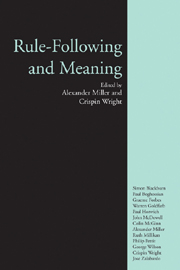Book contents
- Frontmatter
- Contents
- Acknowledgements
- The Contributors
- 1 Introduction
- 2 Skepticism and Semantic Knowledge
- 3 The Individual Strikes Back
- 4 Wittgenstein on Following a Rule
- 5 Wittgenstein, Kripke and Non-Reductionism about Meaning
- 6 Kripke on Wittgenstein on Rules
- 7 Critical Notice of Colin McGinn's Wittgenstein on Meaning
- 8 Meaning and Intention as Judgement Dependent
- 9 The Rule-Following Considerations
- 10 The Reality of Rule-Following
- 11 Truth Rules, Hoverflies, and the Kripke–Wittgenstein Paradox
- 12 Kripke on Wittgenstein on Normativity
- 13 Meaning, Use and Truth
- 14 Kripke's Normativity Argument
- Guide to Further Reading
- Index
11 - Truth Rules, Hoverflies, and the Kripke–Wittgenstein Paradox
- Frontmatter
- Contents
- Acknowledgements
- The Contributors
- 1 Introduction
- 2 Skepticism and Semantic Knowledge
- 3 The Individual Strikes Back
- 4 Wittgenstein on Following a Rule
- 5 Wittgenstein, Kripke and Non-Reductionism about Meaning
- 6 Kripke on Wittgenstein on Rules
- 7 Critical Notice of Colin McGinn's Wittgenstein on Meaning
- 8 Meaning and Intention as Judgement Dependent
- 9 The Rule-Following Considerations
- 10 The Reality of Rule-Following
- 11 Truth Rules, Hoverflies, and the Kripke–Wittgenstein Paradox
- 12 Kripke on Wittgenstein on Normativity
- 13 Meaning, Use and Truth
- 14 Kripke's Normativity Argument
- Guide to Further Reading
- Index
Summary
[T]he skeptical argument that Kripke attributes to Wittgenstein, and even the ‘skeptical solution’, are of considerable importance regardless of whether they are clearly Wittgenstein's. The naturalistically inclined philosopher, who rejects Brentano's irreducibility and yet holds intentionality to be an objective feature of our thoughts, owes a solution to the Kripke-Wittgenstein paradox.
The challenge is a welcome one. Although I will argue that the Kripke- Wittgenstein paradox is not a problem for naturalists only, I will propose a naturalist solution to it. (Should the Kripke-Wittgenstein paradox prove to be soluble from a naturalist standpoint but intractable from other standpoints, that would, I suppose, constitute an argument for naturalism.) Then I will show that the paradox and its solution have an important consequence for the theories of meaning and truth. The Kripke-Wittgenstein arguments which pose the paradox also put in question Dummett's and Putnam's view of language understanding. From this view it follows that truth rules must be “verificationist rules” that assign assertability conditions to sentences, rather than “realist rules” that assign correspondence truth conditions. The proposed solution to the paradox suggests another view of language understanding, according to which a speaker can express, through his language practice, a grasp of correspondence truth rules. This will block one route of Putnam's famous retreat from realism:
The point is that Dummett and I agree that you can't treat understanding a sentence (in general) as knowing its truth conditions; because it then becomes unintelligible what that knowledge in turn consists in. We both agree that the theory of understanding has to be done in a verificationist way . . . conceding that some sort of verificationist semantics must be given as our account of understanding . . . I have given Dummett all he needs to demolish metaphysical realism . . . a picture I was wedded to!
- Type
- Chapter
- Information
- Rule-Following and Meaning , pp. 209 - 233Publisher: Acumen PublishingPrint publication year: 2002
- 1
- Cited by



